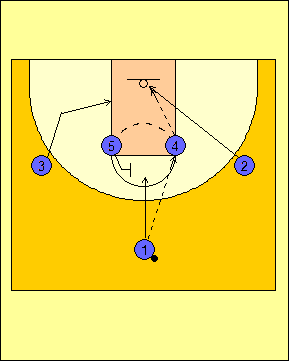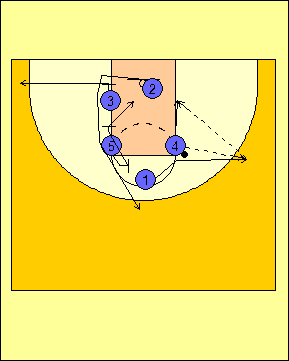|

Basketball Coaching DVD's at Championship Productions
THE 1-4 HIGH OFFENSE
While I was at William Jewell College with Larry Holley, our teams always ran a
1-4 high offense designed to take advantage of pressure and sagging man-to-man
defenses. We felt more comfortable with our personnel running a set
offense and the 1-4 high worked well against either a pressure or sagging man-to-man defense
and it also had its advantages against certain types of zone defenses depending
on how we utilized the offense.
Advantages of the 1-4 High Offense
The 1-4 high offense works great when you have two post players who are
complimentary and three players who can play on the perimeter. This is a
double-post offense and your post players will be working in and around the free
throw lane and free throw circle. Your perimeter players will only go into
the post on rare occasions, but they will mostly stay on the perimeter.
Limiting the area where they have to play can make the offense more simplified
for your players.
Second, the 1-4 high offense is set up in such a way that the point guard has
four near receivers to pass to as a way to start the offense. This allows
the point guard more options as to how he can start the offense. He can
enter with the dribble or the pass to either one of the four players at the
free-throw line extended. This helps especially when the point guard is
facing a pressure man-to-man defense.
Third, the high alignment allows for great backdoor and post-up opportunities.
The posts being brought high allows for post passes to turn into quick hitters
with wing players cutting to the basket. The posts are also set up so that
if there is a dead front of the post, a lob play can become an automatic.
Also, when the ball gets entered to the wing on the dribble or the pass, the
posts can situate themselves in such a way that they can post up high or low to
receive the basketball.
Fourth, the 1-4 high offense works well against zone defenses in that the four
high players can permit entry into the offense either with an entry into either
one of the post players or either one of the perimeter players. The 1-4
high set can be used to get your team into your zone offense.
Finally, the 1-4 high offense, like many other set offenses, is easy to teach
and it can be installed in a matter of days. Unlike motion offense, the
1-4 high offense allows players to learn the system quickly and there is such a
diversity of options that you can take advantage of what your players can do
well.
Disadvantages of the 1-4 High Offense
Like all patterned offenses, the 1-4 high offense has the tendency to be easily
scouted. Actions are all predetermined by what happens based on ball
movement and player movement. Being predictable can get you beat if you
are playing a team that can successfully scout out everything you want to do.
Second, the 1-4 high offense requires three-out/two-in personnel. Very
rarely can you run this offense if you don't have this type of personnel on the
court. Adjustments are necessary and it can put players in a
disadvantageous position if you don't adjust.
Finally, unless you put specific elements of two-man games and three-man games
into your offense, your defense will suffer. Being able to put certain
elements in your 1-4 high offense should help, but you may need to take away
from practice time to work on elements that are not incorporated in your
offense.
Post Option
On our post option play, #1 passes in to either #4 or #5 in the high post (#4 in
illustration). Once ball-side and help-side have been established by the
pass into the post, the ball-side wing will cut to the basket and look for the
backdoor. The help-side post steps out in anticipation of setting a flare
screen for the point guard. The help-side wing will start down the
sideline and go to just above the help-side low block getting ready to set up
for the point guard's decision. From here, the point guard will make a
decision as to which way he goes.
The first option for the point guard is to pop to the
ball-side wing and look for the ball from the post player with the ball.
If the point guard gets the ball, the post who passed it to him is going
to slide down to the ball-side low block and #2 is going to come off of
a stagger double set on the help-side lane line by #3 and #5. The
options for the point guard are as follows: #4, #2, #5 on the slip
to the basket if the screen is switched and #3 on the slip to the
corner. If #1 cannot get the ball, #4 stays put and waits for the
stagger double to develop. In that case, #4 can pass to #2, #5
going to the basket or #3.
|
 
Post Option (Point guard uses two-man game with #4 to set up the
stagger double for #2). |
If the point guard decides to use the flare screen set by #5 and not follow his
pass, #2 will clear out to the ball-side corner and #3 will put his head under
the basket. #4 will look to pass to #1 to set up the double down for #3.
Here, #4 and #5 will set a double down screen for #3 after #1 has received the
ball. Our #3 will come off of the help-side shoulder of #4 and go straight
to the point where he will receive the ball from #1.

© 2010-2017 Alan Peel Enterprises
|